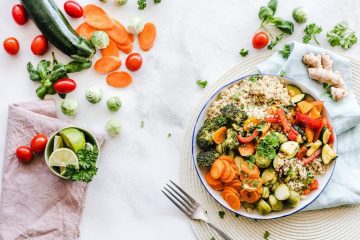Table of Contents
- Understanding the Importance of Potassium in Our Diet
- Top Potassium-Rich Foods You Should Add to Your Grocery List
- Delicious Ways to Incorporate More Potassium Into Your Meals
- The Health Benefits of Maintaining Optimal Potassium Levels
- Common Myths and Facts About Potassium Intake
- Q&A
- Future Outlook


Understanding the Importance of Potassium in Our Diet
Potassium is an essential mineral that plays a critical role in maintaining several bodily functions. It helps regulate fluid balance, supports nerve signals, and aids in muscle contractions. A diet rich in potassium is vital for cardiovascular health, as it helps to lower blood pressure and reduce the risk of stroke. Incorporating potassium-rich foods can significantly contribute to overall wellness and may prevent serious health conditions.
One of the best ways to ensure you’re getting enough potassium is by including a variety of fruits and vegetables in your daily diet. Some particularly potassium-rich options include:
- Bananas: An iconic source, perfect for snacks or smoothies.
- Spinach: A versatile leafy green that can be added to salads or cooked dishes.
- Baked Potatoes: Especially with the skin, these are a delicious way to boost your intake.
- Avocados: Packed with healthy fats and potassium—great for spreads or salads.
- Oranges: Not just refreshing, they are also an excellent source of this essential mineral.
For those looking to monitor their potassium intake more effectively, here is a simple table listing some common foods along with their potassium content per serving:
| Food | Potassium Content (mg) |
|---|---|
| Banana (1 medium) | 422 |
| Sweet Potato (1 medium) | 448 |
| Beet Greens (1 cup, cooked) | 1391 |
| White Beans (1 cup, cooked) | 1189 |
| Yogurt (1 cup) | 531 |
Incorporating these foods into your meals can significantly boost your potassium levels, providing you with numerous health benefits. Whether you’re looking to improve your overall health or simply enjoy a delicious meal packed with nutrition, making potassium a priority in your diet is a worthwhile goal.


Top Potassium-Rich Foods You Should Add to Your Grocery List
When it comes to maintaining optimal health, incorporating foods rich in potassium is essential. This vital mineral supports various bodily functions, including regulating blood pressure and muscle contractions. Here are some delicious options to consider for your next grocery trip:
- Bananas: One of the most well-known sources, a medium banana contains about 422 mg of potassium, making it an easy and tasty snack.
- Sweet Potatoes: Packed with nutrients, a medium sweet potato offers around sweet potato 440 mg. They can be roasted, mashed, or added to soups.
- Spinach: Whether fresh or cooked, spinach is a potassium powerhouse, boasting approximately 840 mg per cooked cup. It’s easy to add into salads, smoothies, or pasta dishes.
- Avocados: Known for their healthy fats, avocados also contain about 975 mg of potassium in a single fruit, making them perfect for toast or guacamole.
- Beans: Varieties such as kidney beans and black beans are fantastic sources, offering over 600 mg of potassium per cooked cup. They can enhance salads, stews, and wraps.
For those looking to diversify their options or incorporate more potassium into their meals, consider the following foods:
| Food | Potassium Content (mg per serving) |
|---|---|
| White Beans | 1,189 |
| Dried Apricots | 1,146 |
| Beet Greens | 1,300 |
| Potatoes | 926 |
| Oranges | 237 |
These potassium-rich foods not only support your body’s needs but also add flavor and variety to your meals. From savory dishes to refreshing snacks, including these options will help you meet your potassium intake while enjoying a diverse diet.


Delicious Ways to Incorporate More Potassium Into Your Meals
One of the simplest ways to boost your potassium intake is by using bananas as a frequent ingredient in your meals. Not only are they naturally sweet and versatile, but they also serve as a fantastic base for smoothies or a topping for oatmeal and yogurt. Consider slicing bananas onto whole-grain pancakes for a hearty breakfast or blending them into a creamy smoothie with spinach and almond milk for a nutrition-packed snack. Experimenting with banana bread can introduce a delightful treat to your day while reinforcing your potassium levels.
Incorporating sweet potatoes into your weekly meal prep can elevate both flavor and nutrition. Roasted sweet potato cubes provide a satisfying side dish, while mashed sweet potatoes can be used as a base for hearty casseroles. For added excitement, you could create sweet potato fries baked with a sprinkle of paprika or enjoy them in a warm salad combined with black beans, corn, and avocado. The versatility of sweet potatoes allows for endless culinary creativity while enriching your diet with essential nutrients.
Don’t overlook the power of leafy greens like spinach, Swiss chard, and kale, which are exceptionally high in potassium. Add these greens to your salads, smoothies, and stir-fries for an easy nutrient boost. You can also make a vibrant green soup by blending cooked spinach with vegetable broth, garlic, and herbs, or toss kale into a pasta dish for added texture and flavor. Here’s a quick reference table of potassium-rich leafy greens:
| Vegetable | Potassium (mg per 100g) |
|---|---|
| Spinach | 558 |
| Swiss Chard | 379 |
| Kale | 491 |


The Health Benefits of Maintaining Optimal Potassium Levels
Maintaining optimal potassium levels is crucial for overall health, benefiting various bodily functions. As an essential mineral, potassium helps regulate fluid balance, nerve signals, and muscle contractions. When your body has sufficient potassium, it can effectively manage blood pressure levels, reducing the risk of hypertension. Lower blood pressure not only improves cardiovascular health but also decreases the likelihood of heart disease and stroke.
Furthermore, this mineral plays a significant role in muscle function and cramp prevention. It helps muscles to contract and relax properly, which is vital for both athletic performance and daily activities. Insufficient potassium can lead to muscle weakness and cramps, impacting your overall physical capability. Keeping potassium levels balanced ensures that your muscles remain strong and responsive, enhancing your physical endurance.
The benefits of potassium also extend to bone health. This mineral contributes to bone density, helping to prevent conditions like osteoporosis, particularly in older adults. Research indicates that adequate potassium intake plays a role in reducing the loss of calcium from bones, thereby supporting their strength and structure. Food sources rich in potassium, such as bananas, sweet potatoes, and spinach, can significantly contribute to meeting your daily needs and fostering long-term health.


Common Myths and Facts About Potassium Intake
When it comes to potassium intake, there are several misconceptions that often cloud our understanding of this vital nutrient. One common myth is that high potassium levels are only a concern for those with kidney problems. In reality, everyone needs to monitor potassium levels, as it plays a crucial role in muscle function, nerve signaling, and balancing fluids in the body. Insufficient intake can lead to fatigue, muscle cramps, and even arrhythmias. Thus, it’s essential to recognize the importance of maintaining adequate potassium levels in a balanced diet.
Another prevalent belief is that bananas are the only significant source of potassium. While bananas are indeed rich in this nutrient, they are far from the only option. A variety of foods offer exceptional potassium content, including:
- Sweet potatoes
- Spinach
- Avocados
- Beans
- Coconut water
In fact, many fruits and vegetables contain high amounts of potassium, making it easy to incorporate into meals and snacks throughout the day.
some people think that increasing potassium intake doesn’t come with risks. However, excessive potassium levels can lead to hyperkalemia, a potentially dangerous condition that can result in cardiac issues. This underscores the need for a well-rounded approach to dietary potassium. Monitoring intake, especially in those with certain health conditions, is essential. It’s advisable to consult with a healthcare provider before making significant dietary changes, particularly for those considering potassium supplements.
Q&A
Q&A: Exploring Foods High in Potassium
Q1: What is potassium and why is it important for our health? A1: Potassium is a vital mineral and electrolyte that plays a significant role in various bodily functions. It helps maintain proper nerve function, regulate muscle contractions, and balance fluids in the body. Adequate potassium intake is essential for maintaining healthy blood pressure and supporting heart health, making it a cornerstone of a balanced diet.Q2: What are some common foods that are rich in potassium? A2: There’s a delightful variety of potassium-rich foods to choose from! Some of the best sources include:
- Bananas: Often the poster fruit for potassium, they boast around 422 mg per medium banana.
- Sweet Potatoes: A single medium sweet potato has approximately 540 mg, along with valuable vitamins and fiber.
- Spinach: This leafy green packs about 840 mg of potassium per cooked cup, making it a powerhouse for health.
- Avocados: A medium avocado provides about 975 mg, plus heart-healthy fats and a creamy texture.
- Beans: Varieties like white beans offer a whopping 1,189 mg per cup when cooked, making them a fantastic vegetarian option.
Q3: How can I incorporate more potassium into my diet? A3: Boosting your potassium intake can be both easy and delicious! Here are some simple strategies:
- Start your day with a smoothie: Blend spinach, banana, and a dollop of yogurt to create a potassium-rich breakfast.
- Snack on fruits: Keep a stash of dried apricots or bananas for a healthy snack on the go.
- Choose leafy greens: Add spinach or kale to salads, soups, and stews for an extra potassium kick.
- Make beans a staple: Incorporate various beans into your meals, whether in salads, chili, or as a side dish.
Q4: Can potassium help in managing high blood pressure? A4: Yes, potassium can play a key role in managing blood pressure levels. It helps counteract the effects of sodium and can assist in relaxing blood vessel walls, which in turn can help reduce blood pressure. Including potassium-rich foods as part of a balanced diet, especially when combined with low sodium intake, can contribute to better cardiovascular health.
Q5: Are there any risks associated with consuming too much potassium? A5: While potassium is essential, excessive intake can lead to hyperkalemia, a condition that can cause heart issues and other serious health problems. This is especially true for individuals with kidney problems, where the body cannot effectively excrete potassium. It’s always important to consult with a healthcare provider before making significant changes to your potassium intake, especially if you have underlying health issues.
Q6: How much potassium do adults need daily? A6: The recommended dietary allowance for potassium varies by age and gender but averages around 2,500 to 3,000 mg for adults. Staying mindful of your potassium levels and striving to meet these requirements through natural food sources can significantly benefit your overall health.
Q7: Are there any alternative sources for people who don’t like bananas? A7: Absolutely! While bananas are popular for their potassium content, there are many alternatives that cater to diverse tastes. Consider snacks like sweet potatoes, cantaloupes, orange juice, and yogurt, or incorporate quinoa and lentils into your meals. The key is to explore and find combinations that excite your palate!
This Q&A aims to educate readers on the importance of potassium while providing practical advice and tips for enhancing their diets, ensuring a richer understanding of this essential nutrient.




0 Comments